Professional Practice Report: Team Dynamics and Interpersonal Skills
VerifiedAdded on 2021/01/02
|18
|5163
|175
Report
AI Summary
This report provides a comprehensive analysis of professional practice, encompassing various aspects such as professional scheduling, training events, and the application of interpersonal skills. The report begins with an introduction to professional practice and its significance in organizational settings, emphasizing the importance of training and development. Part 1 focuses on professional scheduling, utilizing project management software for planning and resourcing, along with the design of a training event that incorporates a range of activities, sessions, workshops, and skills demonstrations. Part 2 delves into workshop sessions on team dynamics, including activity sheets for team-building tasks. Part 3 analyzes the effectiveness and application of interpersonal skills, evaluating team dynamics and critically assessing the author's role within the project. Part 4 highlights the importance of problem-solving techniques and critical reasoning. The report also includes a section on continuous professional development (CPD), discussing personal and career goals, as well as the usage of CPD within organizations and its contribution to the author's learning. The report concludes with a summary of the key findings and recommendations, supported by a list of references.
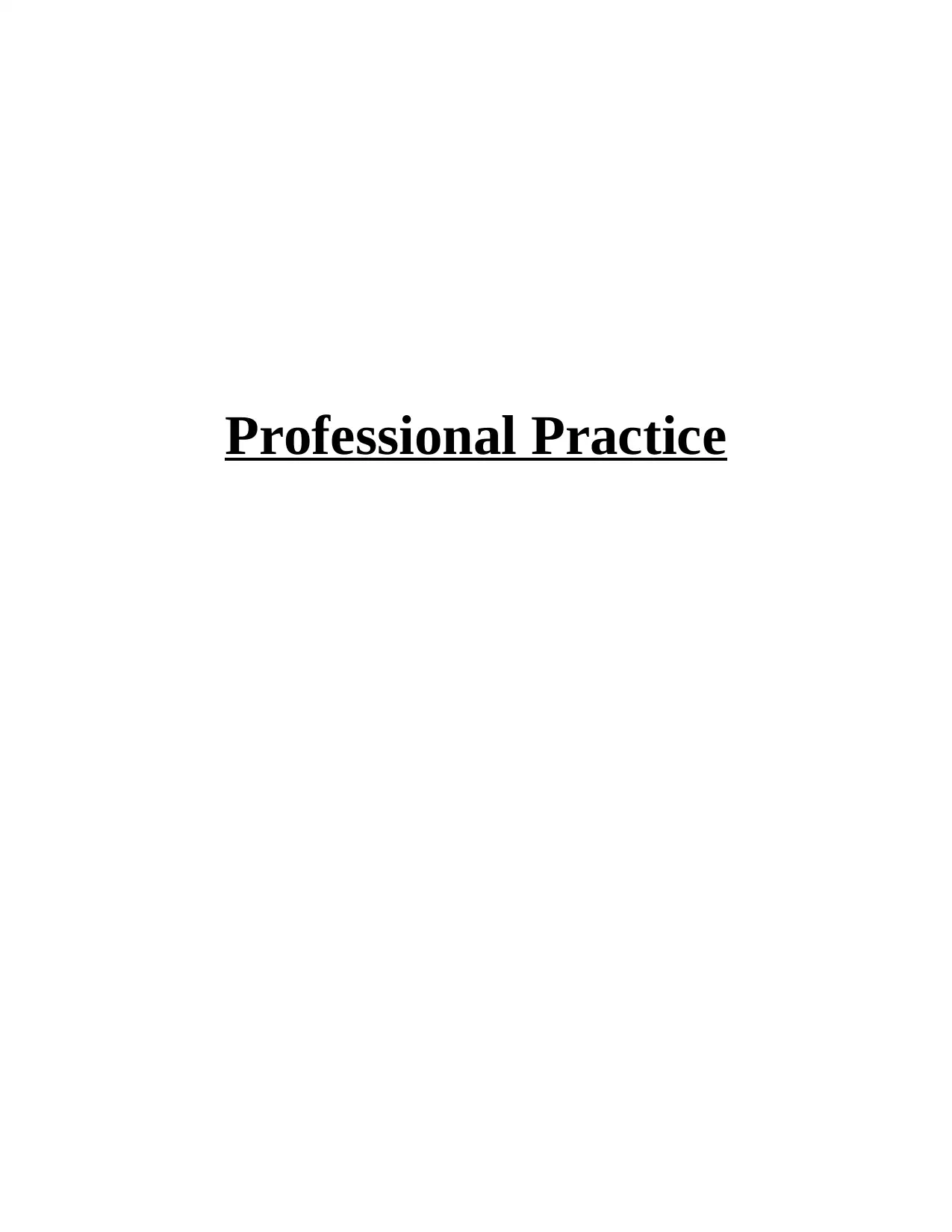
Professional Practice
Paraphrase This Document
Need a fresh take? Get an instant paraphrase of this document with our AI Paraphraser
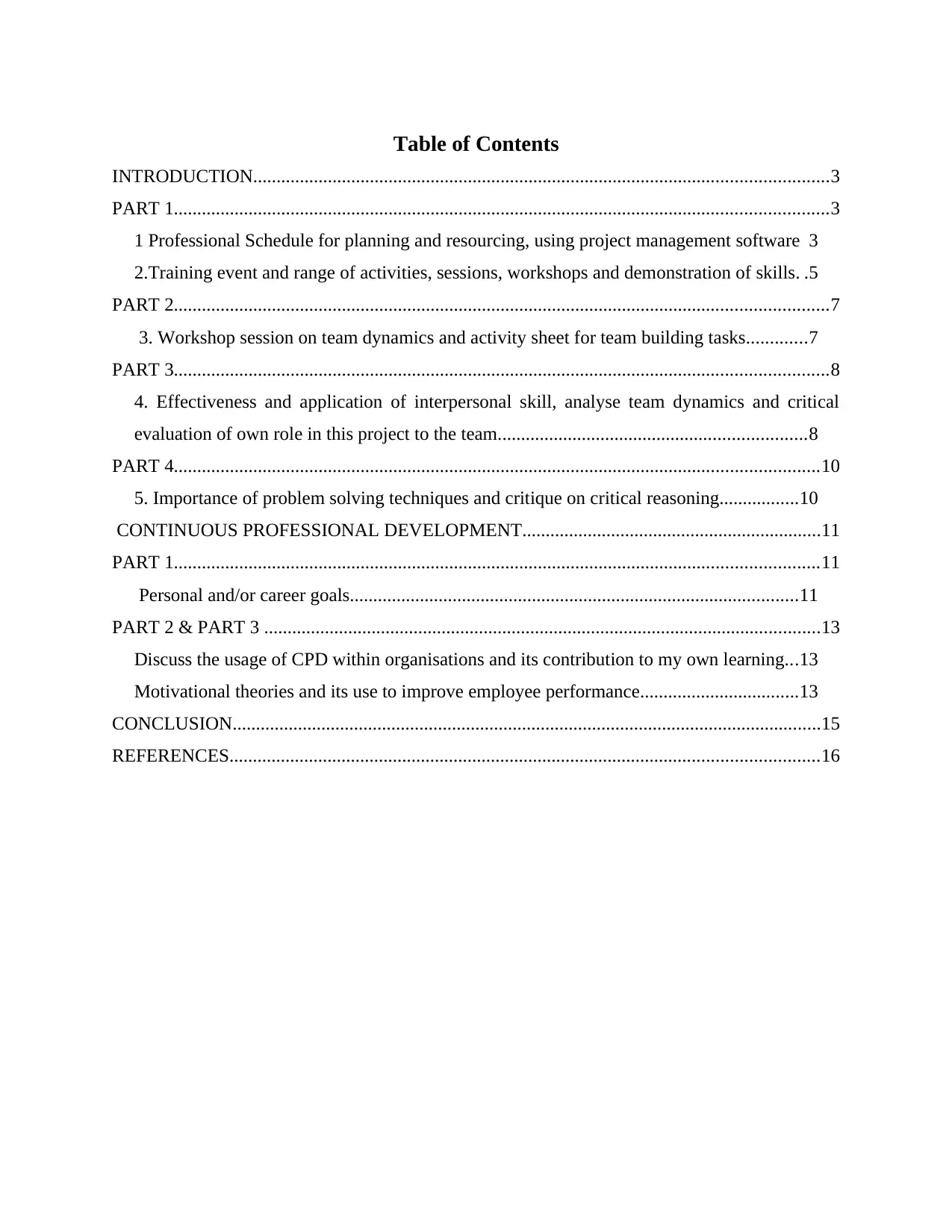
Table of Contents
INTRODUCTION...........................................................................................................................3
PART 1............................................................................................................................................3
1 Professional Schedule for planning and resourcing, using project management software 3
2.Training event and range of activities, sessions, workshops and demonstration of skills. .5
PART 2............................................................................................................................................7
3. Workshop session on team dynamics and activity sheet for team building tasks.............7
PART 3............................................................................................................................................8
4. Effectiveness and application of interpersonal skill, analyse team dynamics and critical
evaluation of own role in this project to the team..................................................................8
PART 4..........................................................................................................................................10
5. Importance of problem solving techniques and critique on critical reasoning.................10
CONTINUOUS PROFESSIONAL DEVELOPMENT................................................................11
PART 1..........................................................................................................................................11
Personal and/or career goals................................................................................................11
PART 2 & PART 3 .......................................................................................................................13
Discuss the usage of CPD within organisations and its contribution to my own learning...13
Motivational theories and its use to improve employee performance..................................13
CONCLUSION..............................................................................................................................15
REFERENCES..............................................................................................................................16
INTRODUCTION...........................................................................................................................3
PART 1............................................................................................................................................3
1 Professional Schedule for planning and resourcing, using project management software 3
2.Training event and range of activities, sessions, workshops and demonstration of skills. .5
PART 2............................................................................................................................................7
3. Workshop session on team dynamics and activity sheet for team building tasks.............7
PART 3............................................................................................................................................8
4. Effectiveness and application of interpersonal skill, analyse team dynamics and critical
evaluation of own role in this project to the team..................................................................8
PART 4..........................................................................................................................................10
5. Importance of problem solving techniques and critique on critical reasoning.................10
CONTINUOUS PROFESSIONAL DEVELOPMENT................................................................11
PART 1..........................................................................................................................................11
Personal and/or career goals................................................................................................11
PART 2 & PART 3 .......................................................................................................................13
Discuss the usage of CPD within organisations and its contribution to my own learning...13
Motivational theories and its use to improve employee performance..................................13
CONCLUSION..............................................................................................................................15
REFERENCES..............................................................................................................................16
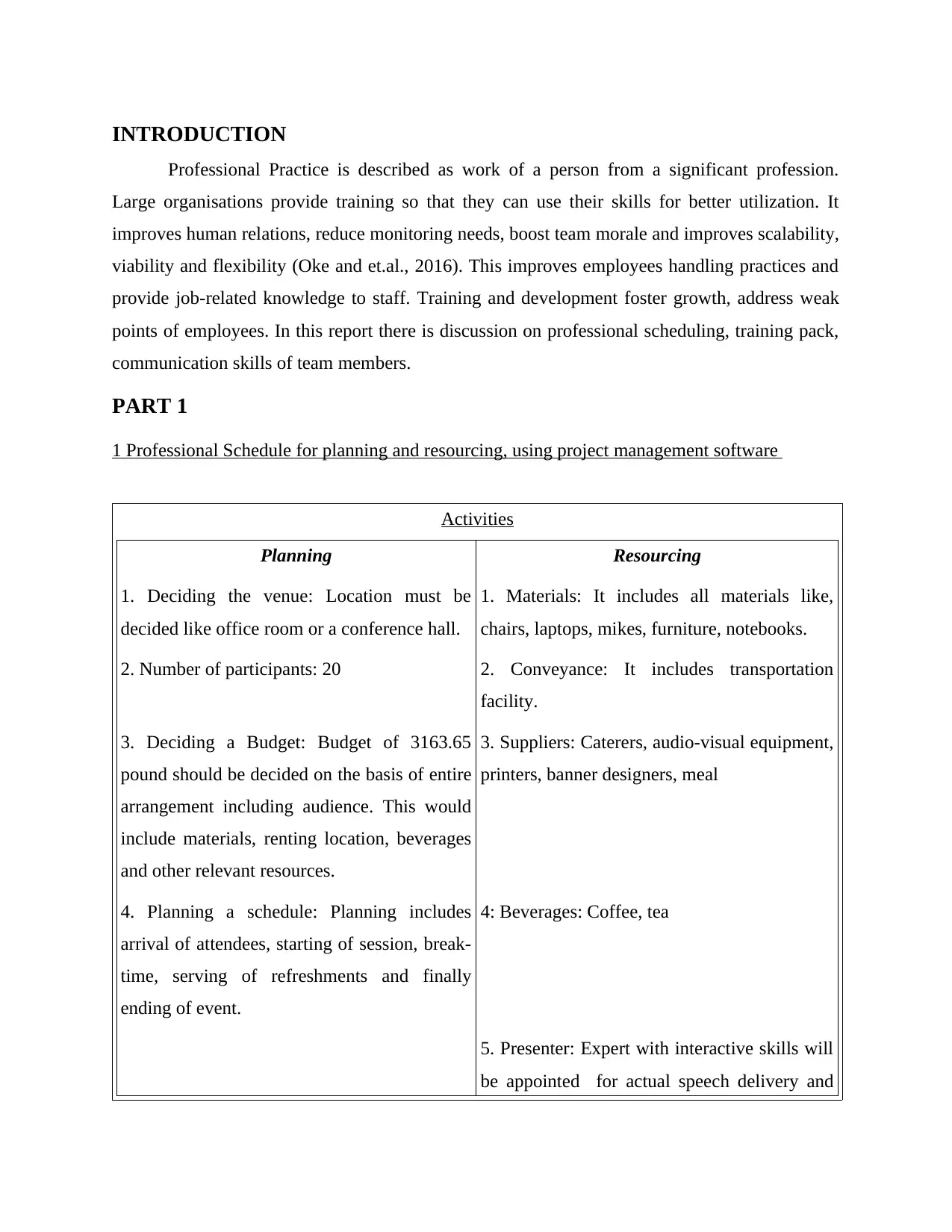
INTRODUCTION
Professional Practice is described as work of a person from a significant profession.
Large organisations provide training so that they can use their skills for better utilization. It
improves human relations, reduce monitoring needs, boost team morale and improves scalability,
viability and flexibility (Oke and et.al., 2016). This improves employees handling practices and
provide job-related knowledge to staff. Training and development foster growth, address weak
points of employees. In this report there is discussion on professional scheduling, training pack,
communication skills of team members.
PART 1
1 Professional Schedule for planning and resourcing, using project management software
Activities
Planning Resourcing
1. Deciding the venue: Location must be
decided like office room or a conference hall.
1. Materials: It includes all materials like,
chairs, laptops, mikes, furniture, notebooks.
2. Number of participants: 20 2. Conveyance: It includes transportation
facility.
3. Deciding a Budget: Budget of 3163.65
pound should be decided on the basis of entire
arrangement including audience. This would
include materials, renting location, beverages
and other relevant resources.
3. Suppliers: Caterers, audio-visual equipment,
printers, banner designers, meal
4. Planning a schedule: Planning includes
arrival of attendees, starting of session, break-
time, serving of refreshments and finally
ending of event.
4: Beverages: Coffee, tea
5. Presenter: Expert with interactive skills will
be appointed for actual speech delivery and
Professional Practice is described as work of a person from a significant profession.
Large organisations provide training so that they can use their skills for better utilization. It
improves human relations, reduce monitoring needs, boost team morale and improves scalability,
viability and flexibility (Oke and et.al., 2016). This improves employees handling practices and
provide job-related knowledge to staff. Training and development foster growth, address weak
points of employees. In this report there is discussion on professional scheduling, training pack,
communication skills of team members.
PART 1
1 Professional Schedule for planning and resourcing, using project management software
Activities
Planning Resourcing
1. Deciding the venue: Location must be
decided like office room or a conference hall.
1. Materials: It includes all materials like,
chairs, laptops, mikes, furniture, notebooks.
2. Number of participants: 20 2. Conveyance: It includes transportation
facility.
3. Deciding a Budget: Budget of 3163.65
pound should be decided on the basis of entire
arrangement including audience. This would
include materials, renting location, beverages
and other relevant resources.
3. Suppliers: Caterers, audio-visual equipment,
printers, banner designers, meal
4. Planning a schedule: Planning includes
arrival of attendees, starting of session, break-
time, serving of refreshments and finally
ending of event.
4: Beverages: Coffee, tea
5. Presenter: Expert with interactive skills will
be appointed for actual speech delivery and
⊘ This is a preview!⊘
Do you want full access?
Subscribe today to unlock all pages.

Trusted by 1+ million students worldwide
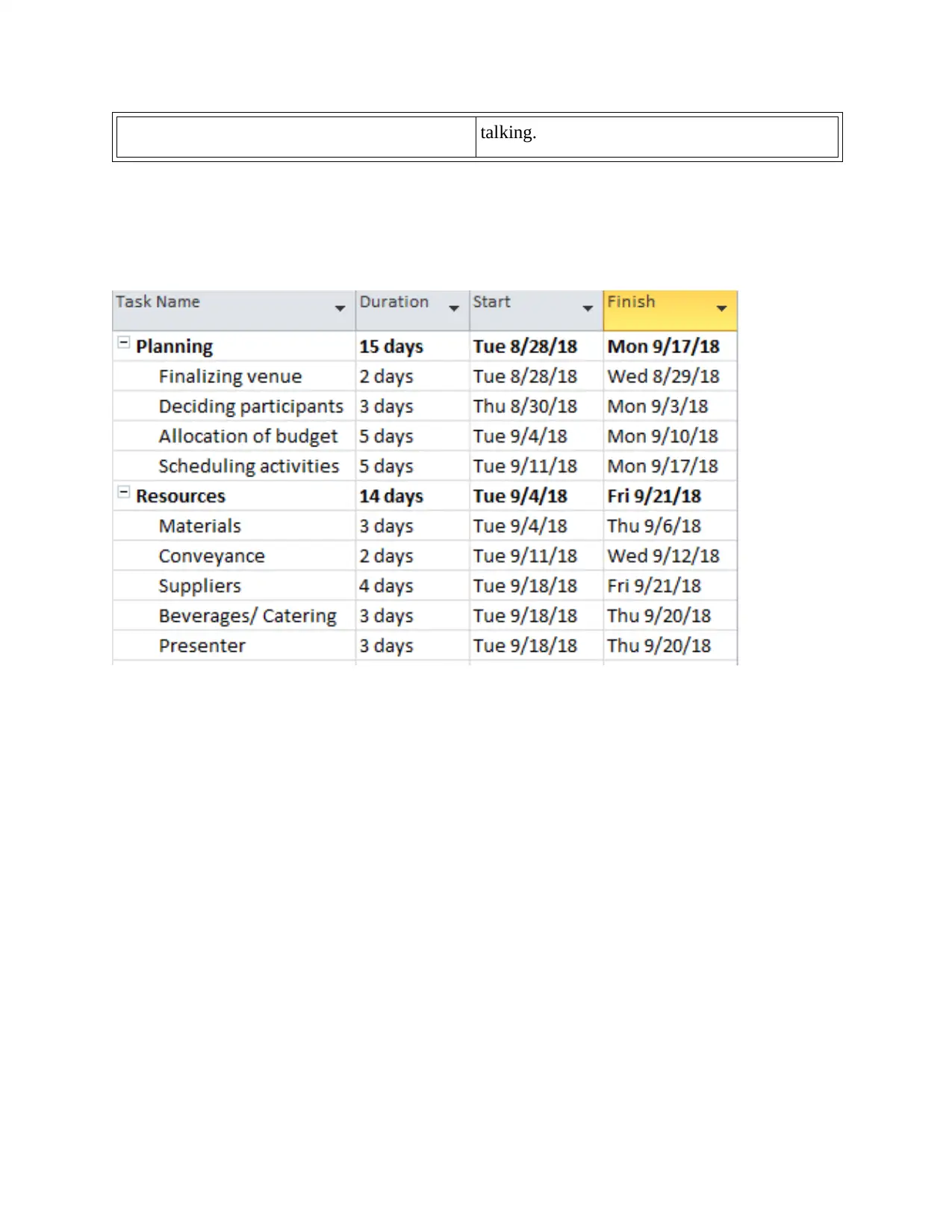
talking.
Paraphrase This Document
Need a fresh take? Get an instant paraphrase of this document with our AI Paraphraser
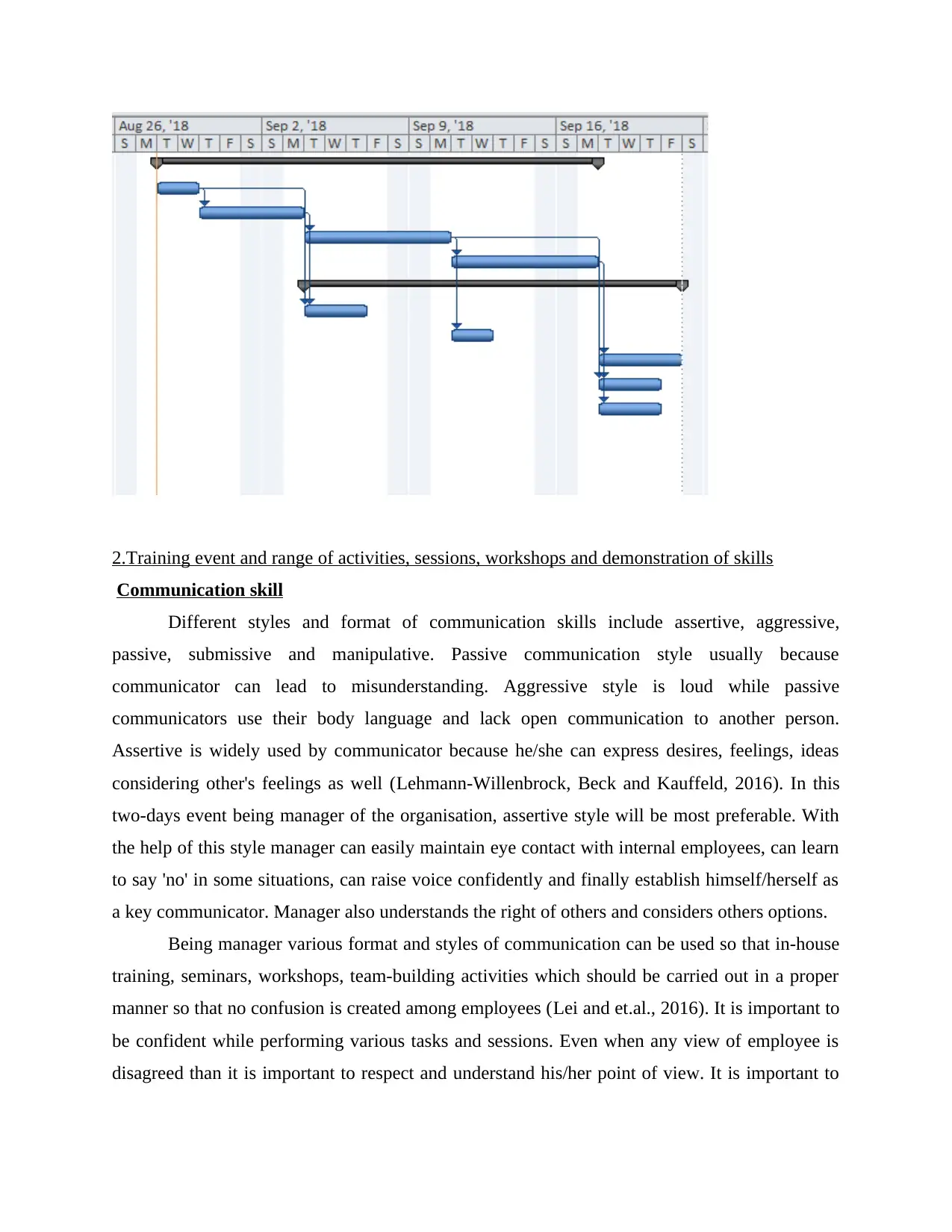
2.Training event and range of activities, sessions, workshops and demonstration of skills
Communication skill
Different styles and format of communication skills include assertive, aggressive,
passive, submissive and manipulative. Passive communication style usually because
communicator can lead to misunderstanding. Aggressive style is loud while passive
communicators use their body language and lack open communication to another person.
Assertive is widely used by communicator because he/she can express desires, feelings, ideas
considering other's feelings as well (Lehmann-Willenbrock, Beck and Kauffeld, 2016). In this
two-days event being manager of the organisation, assertive style will be most preferable. With
the help of this style manager can easily maintain eye contact with internal employees, can learn
to say 'no' in some situations, can raise voice confidently and finally establish himself/herself as
a key communicator. Manager also understands the right of others and considers others options.
Being manager various format and styles of communication can be used so that in-house
training, seminars, workshops, team-building activities which should be carried out in a proper
manner so that no confusion is created among employees (Lei and et.al., 2016). It is important to
be confident while performing various tasks and sessions. Even when any view of employee is
disagreed than it is important to respect and understand his/her point of view. It is important to
Communication skill
Different styles and format of communication skills include assertive, aggressive,
passive, submissive and manipulative. Passive communication style usually because
communicator can lead to misunderstanding. Aggressive style is loud while passive
communicators use their body language and lack open communication to another person.
Assertive is widely used by communicator because he/she can express desires, feelings, ideas
considering other's feelings as well (Lehmann-Willenbrock, Beck and Kauffeld, 2016). In this
two-days event being manager of the organisation, assertive style will be most preferable. With
the help of this style manager can easily maintain eye contact with internal employees, can learn
to say 'no' in some situations, can raise voice confidently and finally establish himself/herself as
a key communicator. Manager also understands the right of others and considers others options.
Being manager various format and styles of communication can be used so that in-house
training, seminars, workshops, team-building activities which should be carried out in a proper
manner so that no confusion is created among employees (Lei and et.al., 2016). It is important to
be confident while performing various tasks and sessions. Even when any view of employee is
disagreed than it is important to respect and understand his/her point of view. It is important to
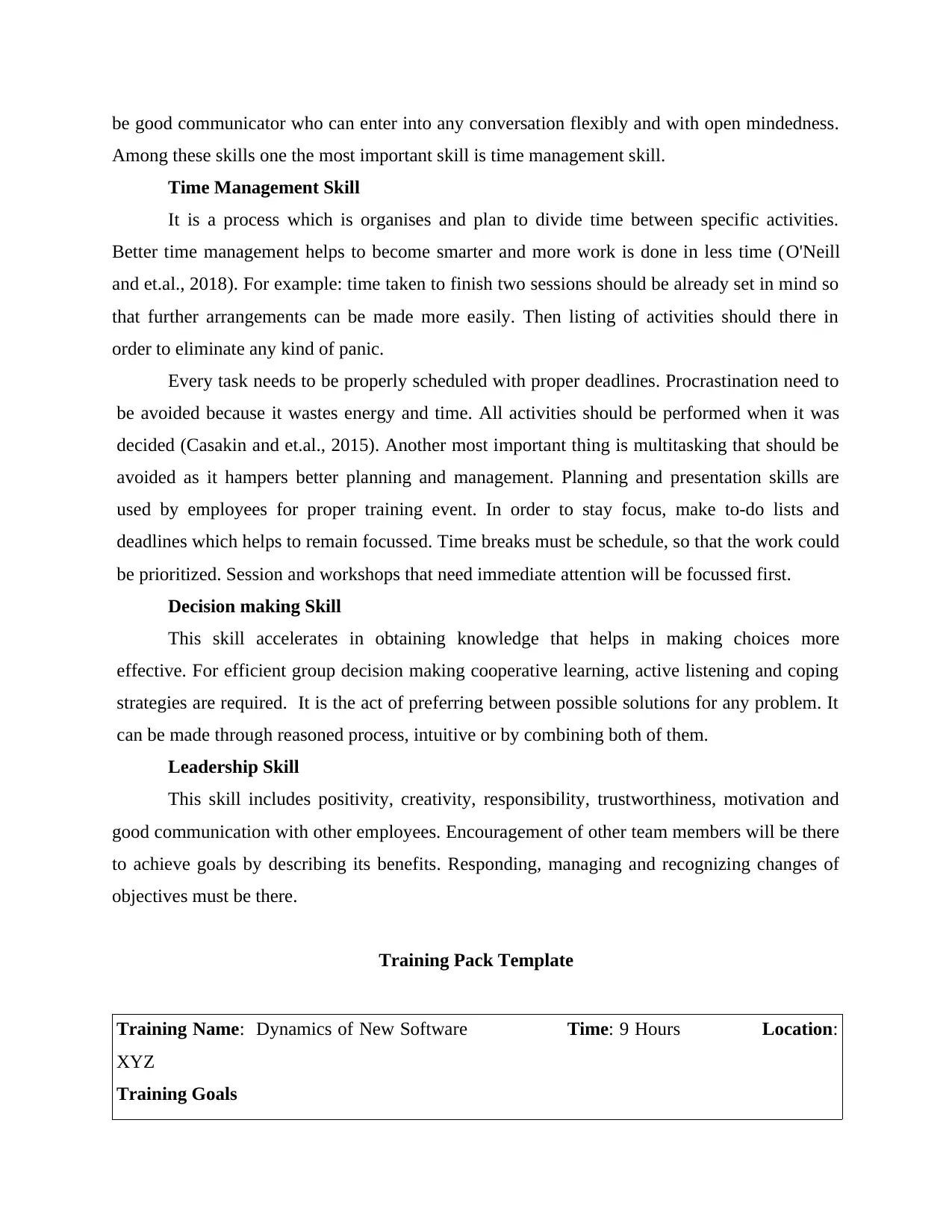
be good communicator who can enter into any conversation flexibly and with open mindedness.
Among these skills one the most important skill is time management skill.
Time Management Skill
It is a process which is organises and plan to divide time between specific activities.
Better time management helps to become smarter and more work is done in less time (O'Neill
and et.al., 2018). For example: time taken to finish two sessions should be already set in mind so
that further arrangements can be made more easily. Then listing of activities should there in
order to eliminate any kind of panic.
Every task needs to be properly scheduled with proper deadlines. Procrastination need to
be avoided because it wastes energy and time. All activities should be performed when it was
decided (Casakin and et.al., 2015). Another most important thing is multitasking that should be
avoided as it hampers better planning and management. Planning and presentation skills are
used by employees for proper training event. In order to stay focus, make to-do lists and
deadlines which helps to remain focussed. Time breaks must be schedule, so that the work could
be prioritized. Session and workshops that need immediate attention will be focussed first.
Decision making Skill
This skill accelerates in obtaining knowledge that helps in making choices more
effective. For efficient group decision making cooperative learning, active listening and coping
strategies are required. It is the act of preferring between possible solutions for any problem. It
can be made through reasoned process, intuitive or by combining both of them.
Leadership Skill
This skill includes positivity, creativity, responsibility, trustworthiness, motivation and
good communication with other employees. Encouragement of other team members will be there
to achieve goals by describing its benefits. Responding, managing and recognizing changes of
objectives must be there.
Training Pack Template
Training Name: Dynamics of New Software Time: 9 Hours Location:
XYZ
Training Goals
Among these skills one the most important skill is time management skill.
Time Management Skill
It is a process which is organises and plan to divide time between specific activities.
Better time management helps to become smarter and more work is done in less time (O'Neill
and et.al., 2018). For example: time taken to finish two sessions should be already set in mind so
that further arrangements can be made more easily. Then listing of activities should there in
order to eliminate any kind of panic.
Every task needs to be properly scheduled with proper deadlines. Procrastination need to
be avoided because it wastes energy and time. All activities should be performed when it was
decided (Casakin and et.al., 2015). Another most important thing is multitasking that should be
avoided as it hampers better planning and management. Planning and presentation skills are
used by employees for proper training event. In order to stay focus, make to-do lists and
deadlines which helps to remain focussed. Time breaks must be schedule, so that the work could
be prioritized. Session and workshops that need immediate attention will be focussed first.
Decision making Skill
This skill accelerates in obtaining knowledge that helps in making choices more
effective. For efficient group decision making cooperative learning, active listening and coping
strategies are required. It is the act of preferring between possible solutions for any problem. It
can be made through reasoned process, intuitive or by combining both of them.
Leadership Skill
This skill includes positivity, creativity, responsibility, trustworthiness, motivation and
good communication with other employees. Encouragement of other team members will be there
to achieve goals by describing its benefits. Responding, managing and recognizing changes of
objectives must be there.
Training Pack Template
Training Name: Dynamics of New Software Time: 9 Hours Location:
XYZ
Training Goals
⊘ This is a preview!⊘
Do you want full access?
Subscribe today to unlock all pages.

Trusted by 1+ million students worldwide
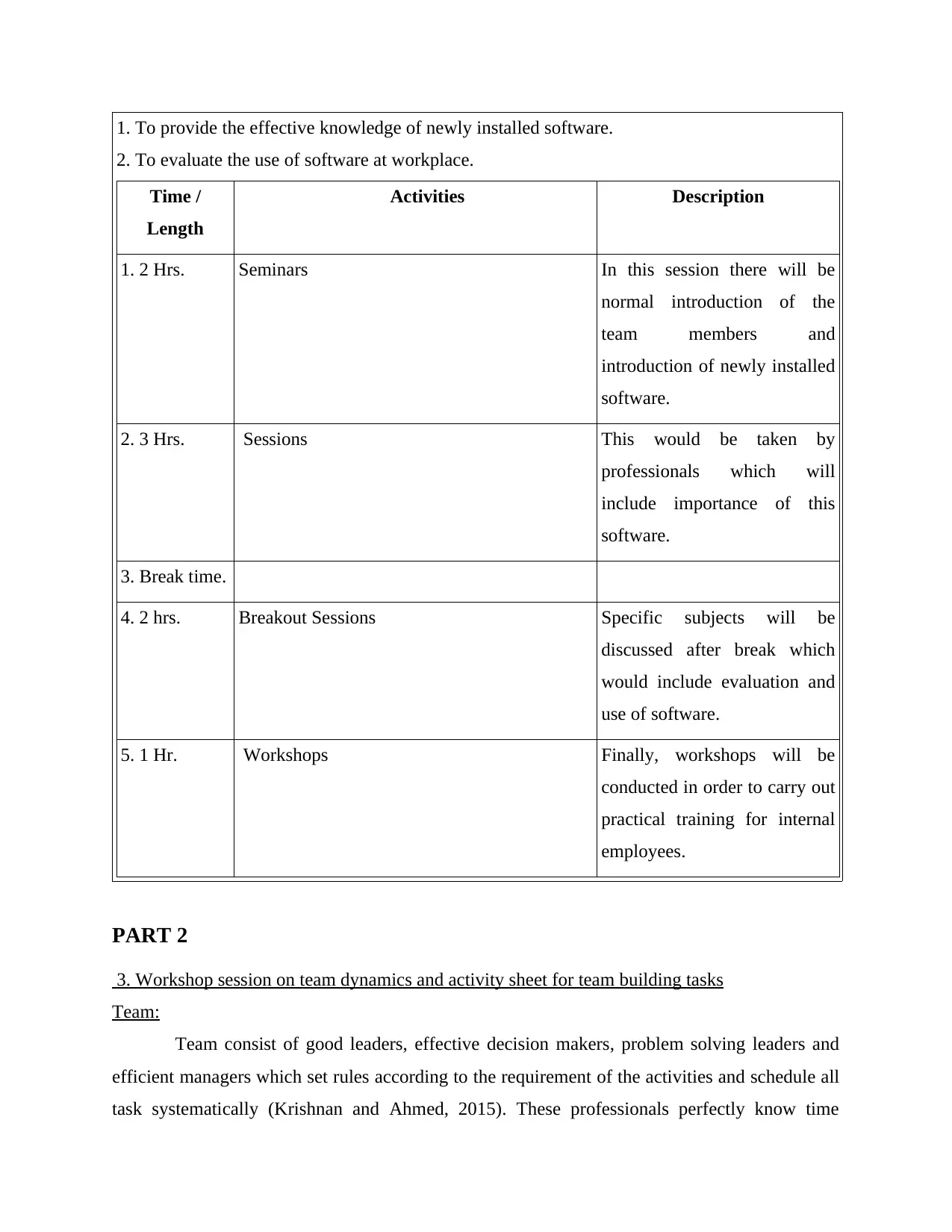
1. To provide the effective knowledge of newly installed software.
2. To evaluate the use of software at workplace.
Time /
Length
Activities Description
1. 2 Hrs. Seminars In this session there will be
normal introduction of the
team members and
introduction of newly installed
software.
2. 3 Hrs. Sessions This would be taken by
professionals which will
include importance of this
software.
3. Break time.
4. 2 hrs. Breakout Sessions Specific subjects will be
discussed after break which
would include evaluation and
use of software.
5. 1 Hr. Workshops Finally, workshops will be
conducted in order to carry out
practical training for internal
employees.
PART 2
3. Workshop session on team dynamics and activity sheet for team building tasks
Team:
Team consist of good leaders, effective decision makers, problem solving leaders and
efficient managers which set rules according to the requirement of the activities and schedule all
task systematically (Krishnan and Ahmed, 2015). These professionals perfectly know time
2. To evaluate the use of software at workplace.
Time /
Length
Activities Description
1. 2 Hrs. Seminars In this session there will be
normal introduction of the
team members and
introduction of newly installed
software.
2. 3 Hrs. Sessions This would be taken by
professionals which will
include importance of this
software.
3. Break time.
4. 2 hrs. Breakout Sessions Specific subjects will be
discussed after break which
would include evaluation and
use of software.
5. 1 Hr. Workshops Finally, workshops will be
conducted in order to carry out
practical training for internal
employees.
PART 2
3. Workshop session on team dynamics and activity sheet for team building tasks
Team:
Team consist of good leaders, effective decision makers, problem solving leaders and
efficient managers which set rules according to the requirement of the activities and schedule all
task systematically (Krishnan and Ahmed, 2015). These professionals perfectly know time
Paraphrase This Document
Need a fresh take? Get an instant paraphrase of this document with our AI Paraphraser
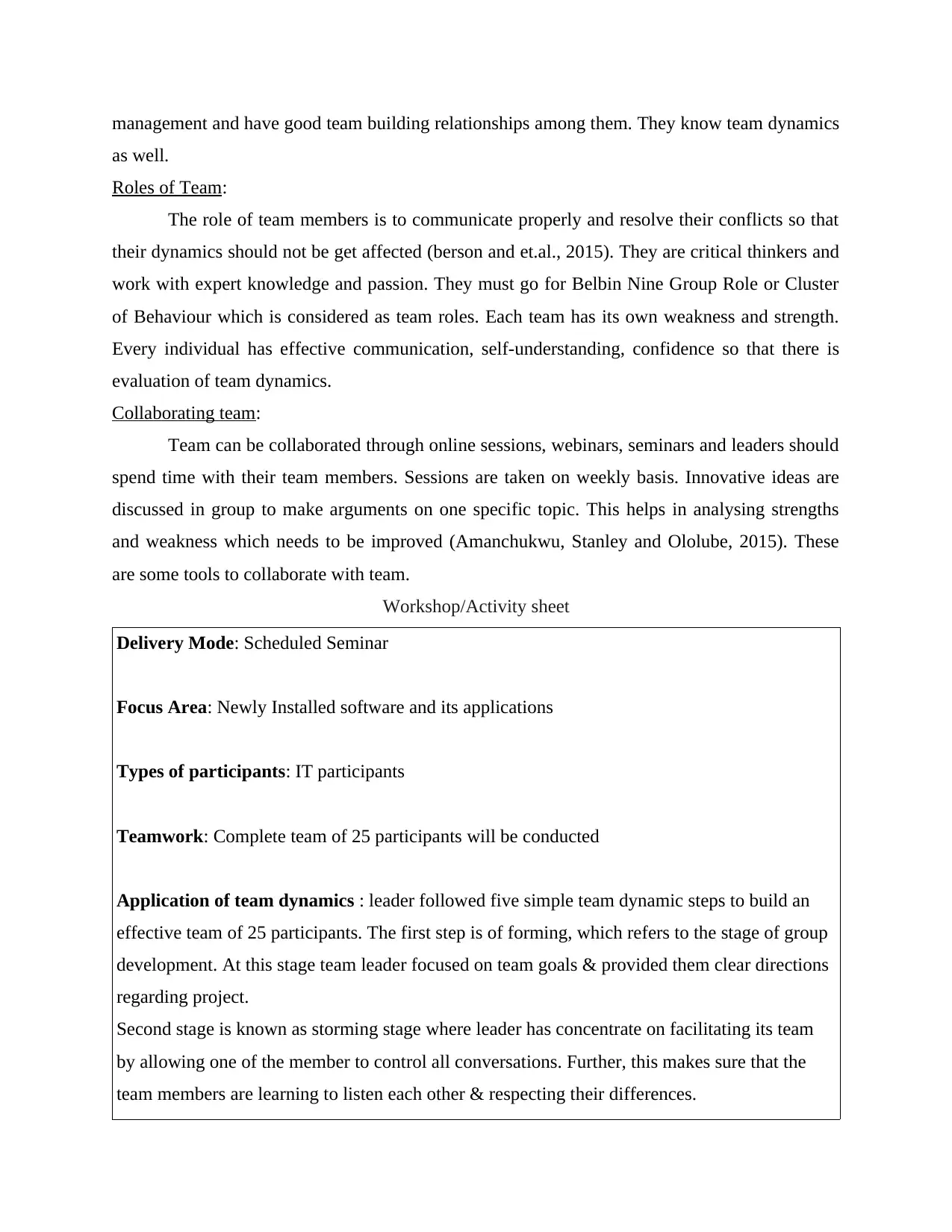
management and have good team building relationships among them. They know team dynamics
as well.
Roles of Team:
The role of team members is to communicate properly and resolve their conflicts so that
their dynamics should not be get affected (berson and et.al., 2015). They are critical thinkers and
work with expert knowledge and passion. They must go for Belbin Nine Group Role or Cluster
of Behaviour which is considered as team roles. Each team has its own weakness and strength.
Every individual has effective communication, self-understanding, confidence so that there is
evaluation of team dynamics.
Collaborating team:
Team can be collaborated through online sessions, webinars, seminars and leaders should
spend time with their team members. Sessions are taken on weekly basis. Innovative ideas are
discussed in group to make arguments on one specific topic. This helps in analysing strengths
and weakness which needs to be improved (Amanchukwu, Stanley and Ololube, 2015). These
are some tools to collaborate with team.
Workshop/Activity sheet
Delivery Mode: Scheduled Seminar
Focus Area: Newly Installed software and its applications
Types of participants: IT participants
Teamwork: Complete team of 25 participants will be conducted
Application of team dynamics : leader followed five simple team dynamic steps to build an
effective team of 25 participants. The first step is of forming, which refers to the stage of group
development. At this stage team leader focused on team goals & provided them clear directions
regarding project.
Second stage is known as storming stage where leader has concentrate on facilitating its team
by allowing one of the member to control all conversations. Further, this makes sure that the
team members are learning to listen each other & respecting their differences.
as well.
Roles of Team:
The role of team members is to communicate properly and resolve their conflicts so that
their dynamics should not be get affected (berson and et.al., 2015). They are critical thinkers and
work with expert knowledge and passion. They must go for Belbin Nine Group Role or Cluster
of Behaviour which is considered as team roles. Each team has its own weakness and strength.
Every individual has effective communication, self-understanding, confidence so that there is
evaluation of team dynamics.
Collaborating team:
Team can be collaborated through online sessions, webinars, seminars and leaders should
spend time with their team members. Sessions are taken on weekly basis. Innovative ideas are
discussed in group to make arguments on one specific topic. This helps in analysing strengths
and weakness which needs to be improved (Amanchukwu, Stanley and Ololube, 2015). These
are some tools to collaborate with team.
Workshop/Activity sheet
Delivery Mode: Scheduled Seminar
Focus Area: Newly Installed software and its applications
Types of participants: IT participants
Teamwork: Complete team of 25 participants will be conducted
Application of team dynamics : leader followed five simple team dynamic steps to build an
effective team of 25 participants. The first step is of forming, which refers to the stage of group
development. At this stage team leader focused on team goals & provided them clear directions
regarding project.
Second stage is known as storming stage where leader has concentrate on facilitating its team
by allowing one of the member to control all conversations. Further, this makes sure that the
team members are learning to listen each other & respecting their differences.
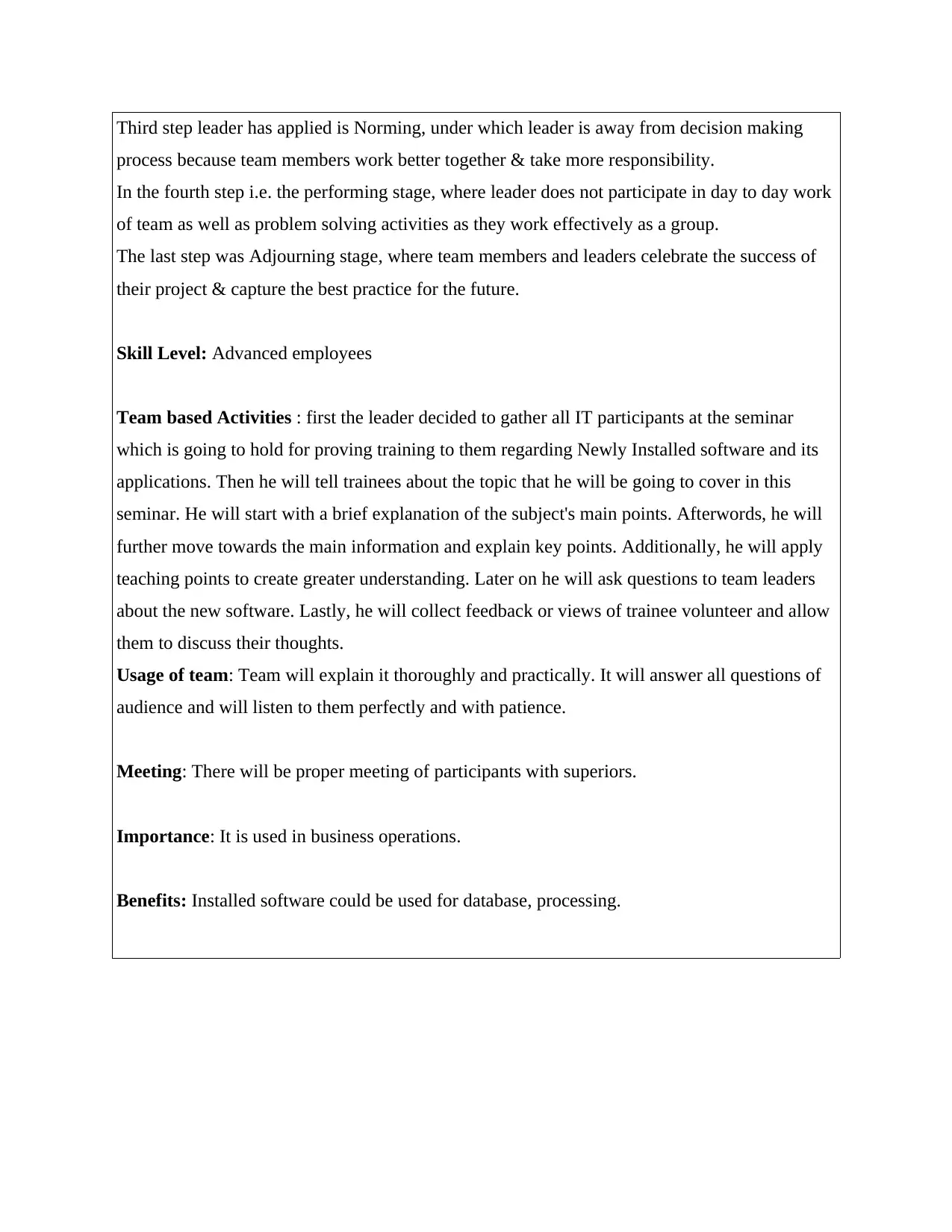
Third step leader has applied is Norming, under which leader is away from decision making
process because team members work better together & take more responsibility.
In the fourth step i.e. the performing stage, where leader does not participate in day to day work
of team as well as problem solving activities as they work effectively as a group.
The last step was Adjourning stage, where team members and leaders celebrate the success of
their project & capture the best practice for the future.
Skill Level: Advanced employees
Team based Activities : first the leader decided to gather all IT participants at the seminar
which is going to hold for proving training to them regarding Newly Installed software and its
applications. Then he will tell trainees about the topic that he will be going to cover in this
seminar. He will start with a brief explanation of the subject's main points. Afterwords, he will
further move towards the main information and explain key points. Additionally, he will apply
teaching points to create greater understanding. Later on he will ask questions to team leaders
about the new software. Lastly, he will collect feedback or views of trainee volunteer and allow
them to discuss their thoughts.
Usage of team: Team will explain it thoroughly and practically. It will answer all questions of
audience and will listen to them perfectly and with patience.
Meeting: There will be proper meeting of participants with superiors.
Importance: It is used in business operations.
Benefits: Installed software could be used for database, processing.
process because team members work better together & take more responsibility.
In the fourth step i.e. the performing stage, where leader does not participate in day to day work
of team as well as problem solving activities as they work effectively as a group.
The last step was Adjourning stage, where team members and leaders celebrate the success of
their project & capture the best practice for the future.
Skill Level: Advanced employees
Team based Activities : first the leader decided to gather all IT participants at the seminar
which is going to hold for proving training to them regarding Newly Installed software and its
applications. Then he will tell trainees about the topic that he will be going to cover in this
seminar. He will start with a brief explanation of the subject's main points. Afterwords, he will
further move towards the main information and explain key points. Additionally, he will apply
teaching points to create greater understanding. Later on he will ask questions to team leaders
about the new software. Lastly, he will collect feedback or views of trainee volunteer and allow
them to discuss their thoughts.
Usage of team: Team will explain it thoroughly and practically. It will answer all questions of
audience and will listen to them perfectly and with patience.
Meeting: There will be proper meeting of participants with superiors.
Importance: It is used in business operations.
Benefits: Installed software could be used for database, processing.
⊘ This is a preview!⊘
Do you want full access?
Subscribe today to unlock all pages.

Trusted by 1+ million students worldwide
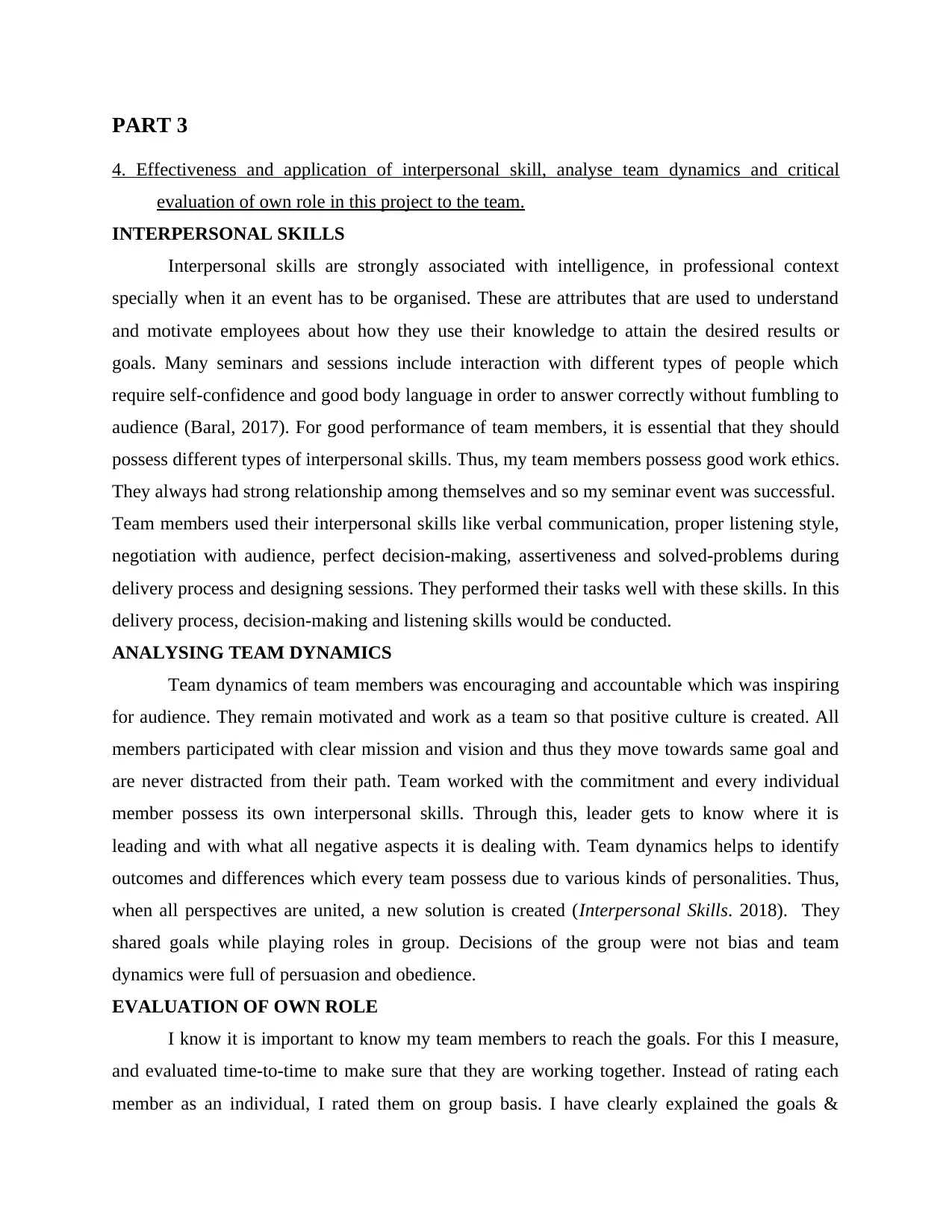
PART 3
4. Effectiveness and application of interpersonal skill, analyse team dynamics and critical
evaluation of own role in this project to the team.
INTERPERSONAL SKILLS
Interpersonal skills are strongly associated with intelligence, in professional context
specially when it an event has to be organised. These are attributes that are used to understand
and motivate employees about how they use their knowledge to attain the desired results or
goals. Many seminars and sessions include interaction with different types of people which
require self-confidence and good body language in order to answer correctly without fumbling to
audience (Baral, 2017). For good performance of team members, it is essential that they should
possess different types of interpersonal skills. Thus, my team members possess good work ethics.
They always had strong relationship among themselves and so my seminar event was successful.
Team members used their interpersonal skills like verbal communication, proper listening style,
negotiation with audience, perfect decision-making, assertiveness and solved-problems during
delivery process and designing sessions. They performed their tasks well with these skills. In this
delivery process, decision-making and listening skills would be conducted.
ANALYSING TEAM DYNAMICS
Team dynamics of team members was encouraging and accountable which was inspiring
for audience. They remain motivated and work as a team so that positive culture is created. All
members participated with clear mission and vision and thus they move towards same goal and
are never distracted from their path. Team worked with the commitment and every individual
member possess its own interpersonal skills. Through this, leader gets to know where it is
leading and with what all negative aspects it is dealing with. Team dynamics helps to identify
outcomes and differences which every team possess due to various kinds of personalities. Thus,
when all perspectives are united, a new solution is created (Interpersonal Skills. 2018). They
shared goals while playing roles in group. Decisions of the group were not bias and team
dynamics were full of persuasion and obedience.
EVALUATION OF OWN ROLE
I know it is important to know my team members to reach the goals. For this I measure,
and evaluated time-to-time to make sure that they are working together. Instead of rating each
member as an individual, I rated them on group basis. I have clearly explained the goals &
4. Effectiveness and application of interpersonal skill, analyse team dynamics and critical
evaluation of own role in this project to the team.
INTERPERSONAL SKILLS
Interpersonal skills are strongly associated with intelligence, in professional context
specially when it an event has to be organised. These are attributes that are used to understand
and motivate employees about how they use their knowledge to attain the desired results or
goals. Many seminars and sessions include interaction with different types of people which
require self-confidence and good body language in order to answer correctly without fumbling to
audience (Baral, 2017). For good performance of team members, it is essential that they should
possess different types of interpersonal skills. Thus, my team members possess good work ethics.
They always had strong relationship among themselves and so my seminar event was successful.
Team members used their interpersonal skills like verbal communication, proper listening style,
negotiation with audience, perfect decision-making, assertiveness and solved-problems during
delivery process and designing sessions. They performed their tasks well with these skills. In this
delivery process, decision-making and listening skills would be conducted.
ANALYSING TEAM DYNAMICS
Team dynamics of team members was encouraging and accountable which was inspiring
for audience. They remain motivated and work as a team so that positive culture is created. All
members participated with clear mission and vision and thus they move towards same goal and
are never distracted from their path. Team worked with the commitment and every individual
member possess its own interpersonal skills. Through this, leader gets to know where it is
leading and with what all negative aspects it is dealing with. Team dynamics helps to identify
outcomes and differences which every team possess due to various kinds of personalities. Thus,
when all perspectives are united, a new solution is created (Interpersonal Skills. 2018). They
shared goals while playing roles in group. Decisions of the group were not bias and team
dynamics were full of persuasion and obedience.
EVALUATION OF OWN ROLE
I know it is important to know my team members to reach the goals. For this I measure,
and evaluated time-to-time to make sure that they are working together. Instead of rating each
member as an individual, I rated them on group basis. I have clearly explained the goals &
Paraphrase This Document
Need a fresh take? Get an instant paraphrase of this document with our AI Paraphraser
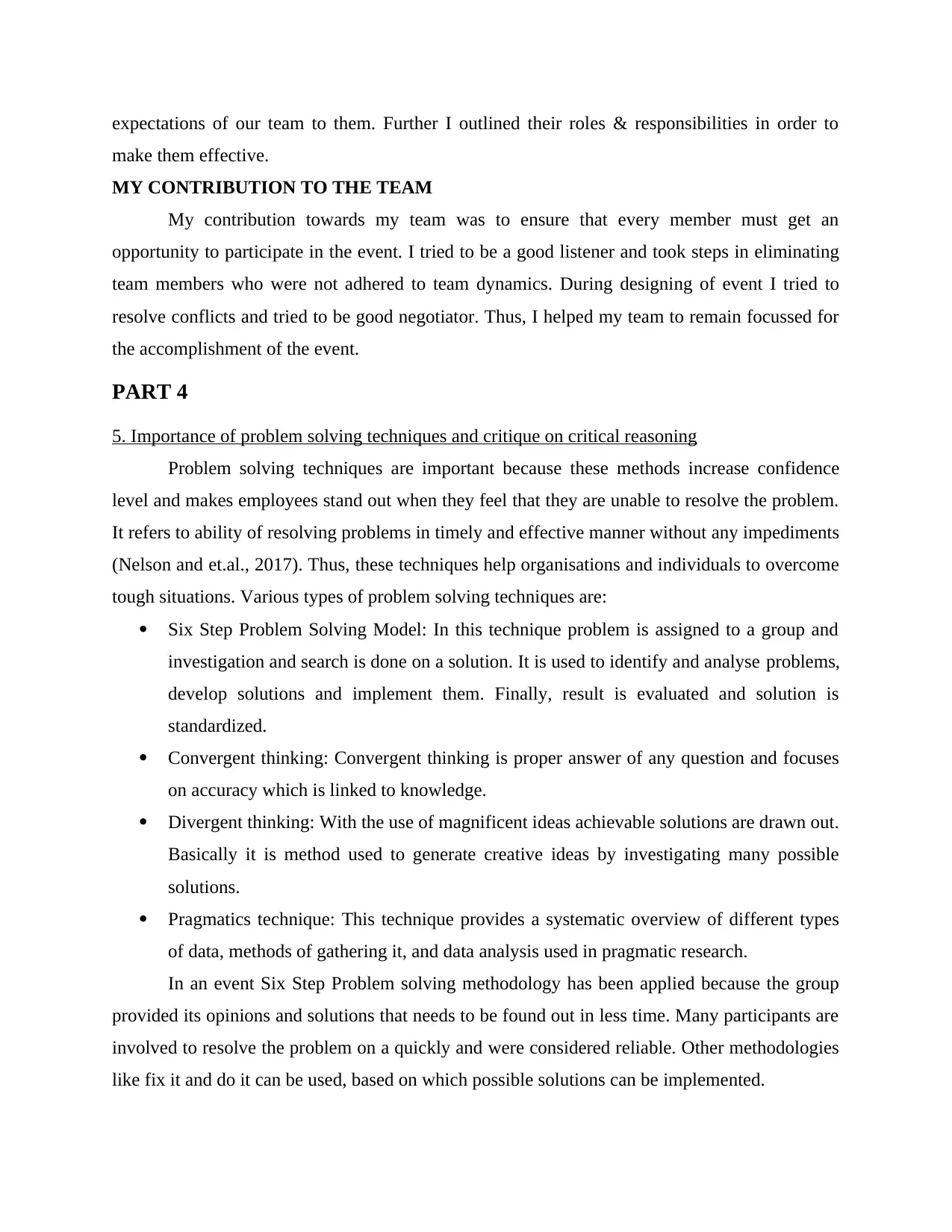
expectations of our team to them. Further I outlined their roles & responsibilities in order to
make them effective.
MY CONTRIBUTION TO THE TEAM
My contribution towards my team was to ensure that every member must get an
opportunity to participate in the event. I tried to be a good listener and took steps in eliminating
team members who were not adhered to team dynamics. During designing of event I tried to
resolve conflicts and tried to be good negotiator. Thus, I helped my team to remain focussed for
the accomplishment of the event.
PART 4
5. Importance of problem solving techniques and critique on critical reasoning
Problem solving techniques are important because these methods increase confidence
level and makes employees stand out when they feel that they are unable to resolve the problem.
It refers to ability of resolving problems in timely and effective manner without any impediments
(Nelson and et.al., 2017). Thus, these techniques help organisations and individuals to overcome
tough situations. Various types of problem solving techniques are:
Six Step Problem Solving Model: In this technique problem is assigned to a group and
investigation and search is done on a solution. It is used to identify and analyse problems,
develop solutions and implement them. Finally, result is evaluated and solution is
standardized.
Convergent thinking: Convergent thinking is proper answer of any question and focuses
on accuracy which is linked to knowledge.
Divergent thinking: With the use of magnificent ideas achievable solutions are drawn out.
Basically it is method used to generate creative ideas by investigating many possible
solutions.
Pragmatics technique: This technique provides a systematic overview of different types
of data, methods of gathering it, and data analysis used in pragmatic research.
In an event Six Step Problem solving methodology has been applied because the group
provided its opinions and solutions that needs to be found out in less time. Many participants are
involved to resolve the problem on a quickly and were considered reliable. Other methodologies
like fix it and do it can be used, based on which possible solutions can be implemented.
make them effective.
MY CONTRIBUTION TO THE TEAM
My contribution towards my team was to ensure that every member must get an
opportunity to participate in the event. I tried to be a good listener and took steps in eliminating
team members who were not adhered to team dynamics. During designing of event I tried to
resolve conflicts and tried to be good negotiator. Thus, I helped my team to remain focussed for
the accomplishment of the event.
PART 4
5. Importance of problem solving techniques and critique on critical reasoning
Problem solving techniques are important because these methods increase confidence
level and makes employees stand out when they feel that they are unable to resolve the problem.
It refers to ability of resolving problems in timely and effective manner without any impediments
(Nelson and et.al., 2017). Thus, these techniques help organisations and individuals to overcome
tough situations. Various types of problem solving techniques are:
Six Step Problem Solving Model: In this technique problem is assigned to a group and
investigation and search is done on a solution. It is used to identify and analyse problems,
develop solutions and implement them. Finally, result is evaluated and solution is
standardized.
Convergent thinking: Convergent thinking is proper answer of any question and focuses
on accuracy which is linked to knowledge.
Divergent thinking: With the use of magnificent ideas achievable solutions are drawn out.
Basically it is method used to generate creative ideas by investigating many possible
solutions.
Pragmatics technique: This technique provides a systematic overview of different types
of data, methods of gathering it, and data analysis used in pragmatic research.
In an event Six Step Problem solving methodology has been applied because the group
provided its opinions and solutions that needs to be found out in less time. Many participants are
involved to resolve the problem on a quickly and were considered reliable. Other methodologies
like fix it and do it can be used, based on which possible solutions can be implemented.
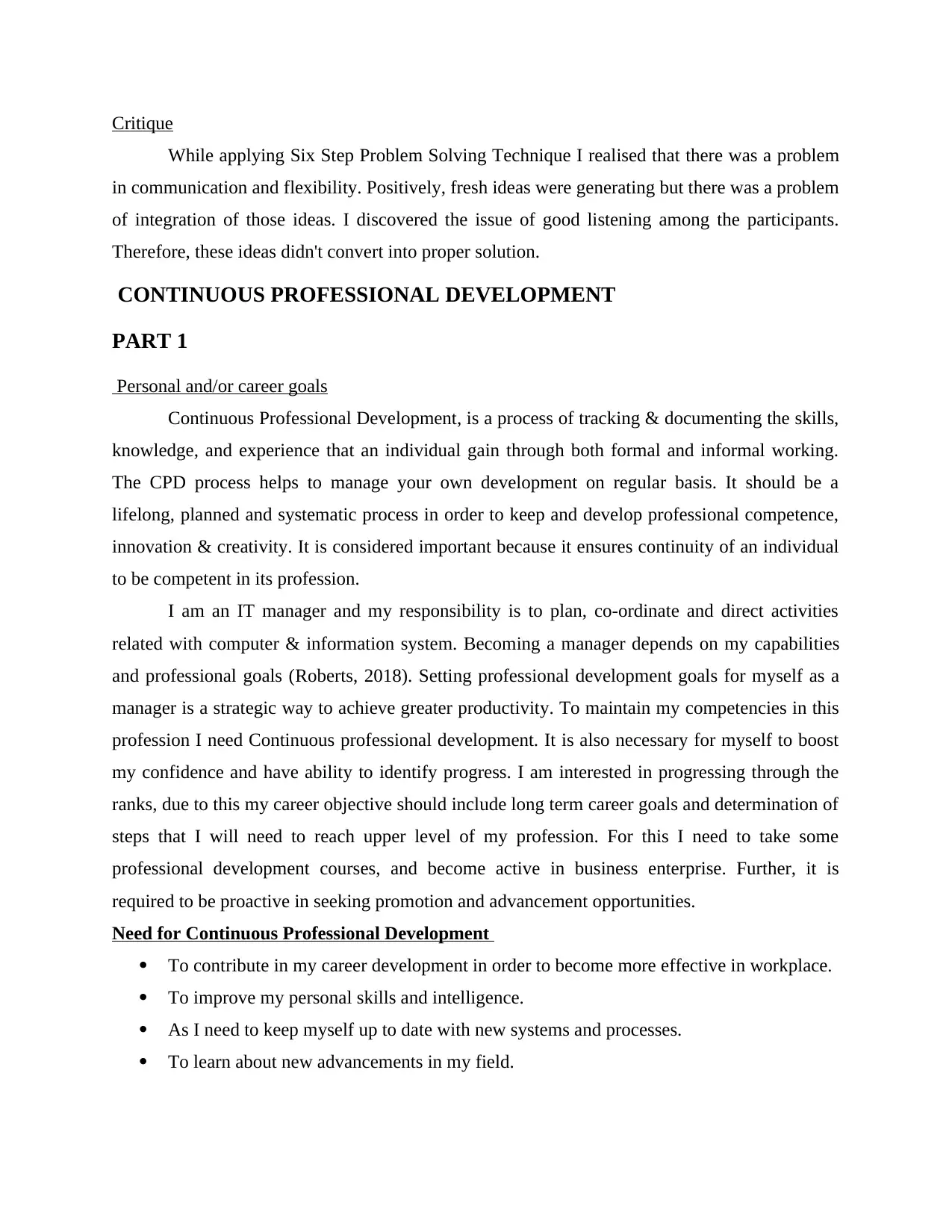
Critique
While applying Six Step Problem Solving Technique I realised that there was a problem
in communication and flexibility. Positively, fresh ideas were generating but there was a problem
of integration of those ideas. I discovered the issue of good listening among the participants.
Therefore, these ideas didn't convert into proper solution.
CONTINUOUS PROFESSIONAL DEVELOPMENT
PART 1
Personal and/or career goals
Continuous Professional Development, is a process of tracking & documenting the skills,
knowledge, and experience that an individual gain through both formal and informal working.
The CPD process helps to manage your own development on regular basis. It should be a
lifelong, planned and systematic process in order to keep and develop professional competence,
innovation & creativity. It is considered important because it ensures continuity of an individual
to be competent in its profession.
I am an IT manager and my responsibility is to plan, co-ordinate and direct activities
related with computer & information system. Becoming a manager depends on my capabilities
and professional goals (Roberts, 2018). Setting professional development goals for myself as a
manager is a strategic way to achieve greater productivity. To maintain my competencies in this
profession I need Continuous professional development. It is also necessary for myself to boost
my confidence and have ability to identify progress. I am interested in progressing through the
ranks, due to this my career objective should include long term career goals and determination of
steps that I will need to reach upper level of my profession. For this I need to take some
professional development courses, and become active in business enterprise. Further, it is
required to be proactive in seeking promotion and advancement opportunities.
Need for Continuous Professional Development
To contribute in my career development in order to become more effective in workplace.
To improve my personal skills and intelligence.
As I need to keep myself up to date with new systems and processes.
To learn about new advancements in my field.
While applying Six Step Problem Solving Technique I realised that there was a problem
in communication and flexibility. Positively, fresh ideas were generating but there was a problem
of integration of those ideas. I discovered the issue of good listening among the participants.
Therefore, these ideas didn't convert into proper solution.
CONTINUOUS PROFESSIONAL DEVELOPMENT
PART 1
Personal and/or career goals
Continuous Professional Development, is a process of tracking & documenting the skills,
knowledge, and experience that an individual gain through both formal and informal working.
The CPD process helps to manage your own development on regular basis. It should be a
lifelong, planned and systematic process in order to keep and develop professional competence,
innovation & creativity. It is considered important because it ensures continuity of an individual
to be competent in its profession.
I am an IT manager and my responsibility is to plan, co-ordinate and direct activities
related with computer & information system. Becoming a manager depends on my capabilities
and professional goals (Roberts, 2018). Setting professional development goals for myself as a
manager is a strategic way to achieve greater productivity. To maintain my competencies in this
profession I need Continuous professional development. It is also necessary for myself to boost
my confidence and have ability to identify progress. I am interested in progressing through the
ranks, due to this my career objective should include long term career goals and determination of
steps that I will need to reach upper level of my profession. For this I need to take some
professional development courses, and become active in business enterprise. Further, it is
required to be proactive in seeking promotion and advancement opportunities.
Need for Continuous Professional Development
To contribute in my career development in order to become more effective in workplace.
To improve my personal skills and intelligence.
As I need to keep myself up to date with new systems and processes.
To learn about new advancements in my field.
⊘ This is a preview!⊘
Do you want full access?
Subscribe today to unlock all pages.

Trusted by 1+ million students worldwide
1 out of 18
Related Documents
Your All-in-One AI-Powered Toolkit for Academic Success.
+13062052269
info@desklib.com
Available 24*7 on WhatsApp / Email
![[object Object]](/_next/static/media/star-bottom.7253800d.svg)
Unlock your academic potential
Copyright © 2020–2025 A2Z Services. All Rights Reserved. Developed and managed by ZUCOL.





